It’s very easy to see that a product is made of plastic, it’s a material that we see all around us every day. There can be no doubt at the way that plastics have helped innovate solutions for so many problems in life, but we now find ourselves looking for ways to reduce plastic use and deal with a huge amount of waste that can be difficult to recycle.
Contents
The Main Groups
Plastics can be categorised into seven groups (plus two variants), each made in a different way and needing to have a different approach for recycling:
| Group Number | Name | Abbreviation Used |
|---|---|---|
| 1 | Polyethylene Terephthalate | PET (or PETE) |
| 2 | High Density Polyethylene | HDPE (or PE-HD) |
| 3 | Polyvinyl Chloride | PVC (or P) |
| 4 | Low Density Polyethylene | LDPE (or PE-LD) |
| 5 | Polypropylene | PP |
| 6 | Polystyrene | PS |
| 7 | Other Plastics | OTHER (or O) |
| ABS | Acrylonitrile Butadiene Styrene | ABS |
| PA | Polyamide | PA |
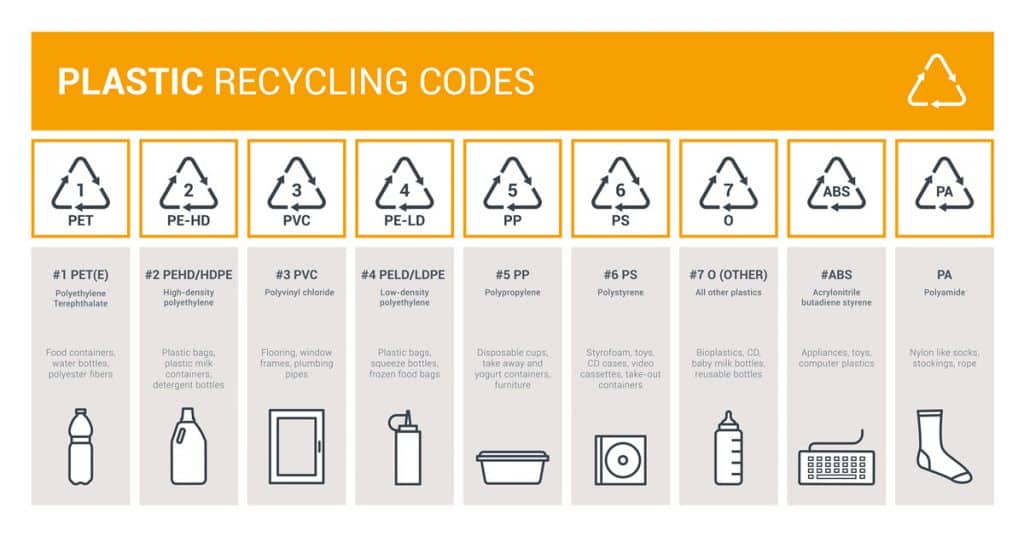
Confused? You’re not alone! While some people recognise the three arrow logos forming a triangle around a number represent plastic types and recycling, very few outside the industry know what they mean or the implications.
Any plastic product should have one of the above symbols printed on it somewhere. The Number or abbreviation indicates the type of plastic that it’s made with. Some products are more obvious that others to people who know their symbols.
For example, cling film and bubble wrap belong in group four (LDPE) with plastic carrier bags. Bottles can be harder to identify from look lone though – as an example, single use water bottles can falls into a different group to re-usable ones. You can read more about bubble wrap recycling in our post here.
Below, we’re going to take a deep dive into plastics, and hopefully all will become clear.
The Seven Plastic Recycling Groups
Group 1: PET – Polyethylene Terephthalate
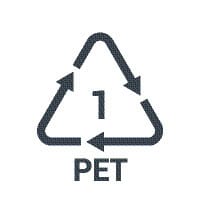
First up we’ve got group one which is the PET group (sometimes also referred to as PETE). Polyethylene Terephthalate is a bit of a mouthful to pronounce, but as a rule of thumb accounts for the type of plastic that bottles that come in your weekly food shop are made from.
This is due to its suitability for contact with food, preventing contamination of consumables. The FSA in the UK, FDA in the US and most countries around the world have approved PET plastics in group 1 as most suitable for food and drink containers.
Contrary to some reports, particularly online, PET plastics do not contain BPA (Bispenol A), so cannot be a health risk based on transferring BPA into food or drink. PET plastics are also safe for freezing.
It is important to note that it is not recommended to heat PET plastics, especially those that contain food or drink for consumption, as this carries a small risk of contamination.
In terms of recycling, PET plastic is very widely recycled and easy to do, as this is the type of plastic you can put into your recycling wheelie bin at home.
Examples Of PET Plastics
- Fizzy drinks bottles
- Plastic food jars
- Ketchup bottles
Group 2: HDPE – High Density Polyethylene
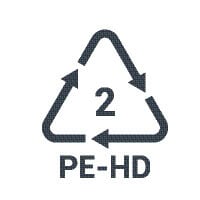
The second group is HDPE. While it’s far from exclusive, the type of plastic that falls into the High Density Polyethylene group are cosmetic and personal hygiene plastic containers like shower gel bottles.
You’ll also find HDPE plastic containers are used for some foods too, generally where the foodstuff is dry, and certainly not liquid, as they could gradually bleed into the plastic and vice versa.
Generally containers made from HDPE tend to be more rigid than PET plastics in group one, and are more resilient to heat.
Like the PET plastics in group one, group 2 HDPE plastics can also go into recycle bins.
Examples Of HDPE Plastics
- Pepper corns & rock salt containers
- Shampoo bottles
- Hand soap bottle
- Sun block spray bottle
- Plastic milk containers
Group 3: PVC – Polyvinyl Chloride
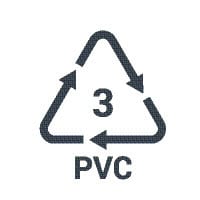
Group three is PVC, Polyvinyl Chloride. This group is not recycled much at all. It’s one of the most problematic in terms of toxins if it’s damaged with heat, and that’s bad news in the case of house fires, as if they weren’t bad enough, melting window frames cause seriously hazardous fumes.
The most likely time you’ll have encountered PVC is as part of the abbreviation uPVC, used to describe plastic window frames.
PVC is particularly good for chemicals which means that you’ll often find it’s used in containers for domestic cleaning products. This is down to the ability of PVC plastics to stay watertight for very long periods without being damaged by the chemical contents.
PVC is also well suited to flooring that’s needing to be cleaned quickly, regularly and easily. You’ll find such vinyl flooring in hospitals and more generally in kitchens and bathrooms as it isn’t damaged by spills, and is easily cleaned up.
Group 3 plastics in the PVC category are not accepted as part of kerbside collections for recycling.
Examples Of PVC Plastics
- Vinyl floor coverings
- Cleaning product bottles
- Window frames
- Door frames
- Plumbing pipes
- Traditional cling film
Group 4: LDPE – Low Density Polyethylene
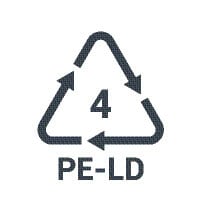
The fourth plastic group is LDPE, Low Density Polyethylene. Like group 3, LDPE is tough to recycle and facilities to carry it out in the UK are very limited.
Fortunately, a growing number of soft plastics recycling bins are appearing through waste networks including those provided at supermarkets.
As a rule of thumb, group 4 low density polyethylene plastics are not suitable for domestic recycling collections, however they’re becoming more common at council run recycling centres as well as supermarkets as time goes on.
Examples Of LDPE Plastics
- Bread bags
- Non PVC Cling Film
- Bubble Wrap
- Sandwich bags
- Some crisp Packets
- Kitchen chopping boards
- Supermarket ‘Bags For Life’
Group 5: PP – Polypropylene
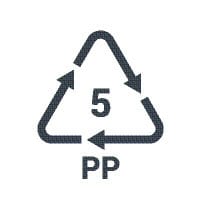
The fifth group uses the symbol PP, denoting Polypropylene. It’s a common plastic used in the automotive industry, for example bumpers on the external trim and dashboards in the interiors.
Group 5 plastics have had a notoriously bad record for recycling, resulting in major chains like McDonalds making the switch from plastic straws to paper alternatives in recent years.
As you might have guessed from the McDonalds reference and them moving away from plastic straws, group five polypropylene is very difficult to recycle and should never go into your recycle bins at home. They can however be taken to recycling centres for specialist recycling or disposal.
Examples Of PP Plastics
- Spray fat bottles
- Most crisp packets
- Yoghurt pots
- Drinks straws
- Cereal bags (the inner packaging inside the box)
- Plastic tableware (plates, disposable cutlery)
- Included in some single use nappies
- Flower pots
- Ready meal noodle pots
Group 6: PS – Polystyrene
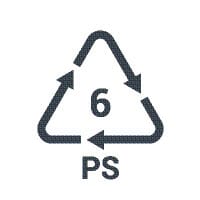
Group six is PS, referring to Polystyrene (including expanded polystyrene, or EPS). There are variations in naming due to trademarks, including Styrofoam which is a specific brand and type of polystyrene.
There’s also those infuriating bits of foam polystyrene that some companies use to pad out parcel boxes.
A lot of work has gone into trying to find better methods to recycle these plastics, due to the fact that some industries rely so heavily upon them with relatively few alternatives. A great example is the food trays used by takeaways.
Unfortunately there are still very few solutions for recycling PS or EPS in the UK, so that also means that while you can’t put it in your plastics recycling bin, you likely can’t get it recycled at the local tip either.
Examples Of PS Plastics
- Product packaging & padding
- Foam style egg cartons
- Take away trays/containers
- Insulated takeaway coffee cups
Group 7: OTHER – Other Plastics
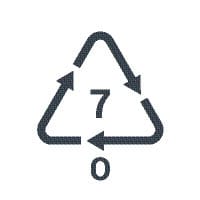
As the name suggests, category seven is a catch all for everything that doesn’t fit nicely into one of the first six groups.
As we’ll get to in a moment, there are a couple of additional groups that have been added since the original categories were defined, so consider group seven to contain any plastics that aren’t included in other categories.
As this category is a catch all, like the polystryrene in group six, you’re likely to be dealing with waste that has to go into your general waste bin. It’s not ideal we know, but there’s little chance you’ll find a way to dispose of this rubbish more responsibly unless you have huge amount of it (in other words, group seven recycling is likely to be limited to commercial waste).
Items that fall into this ‘Other’ category can include the next two categories, as not all countries and manufacturers recognise the additional groups.
Examples Of OTHER Plastics
- Baby bottles
- CDs
- DVDs
The Two Additional Plastic Recycling Groups
Group 8: ABS – Acrylonitrile Butadiene Styrene
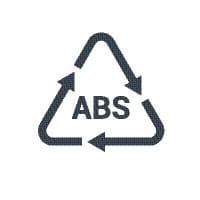
The first additional plastic group, ABS (or Acrylonitril Butadiene Styrene) is most easily described by referring to Lego bricks. The kids toys are well known for being hard, strong and distinctively moulded into the shape of the iconic brand’s building blocks.
It is popular with manufacturers where detailed styling is required such as TV casing.
There are several other products that currently use ABS plastics too, mainly moulded cases for tech products.
From a disposal perspective, these are treated like the OTHER category.
Examples Of ABS Plastics
- Lego bricks
- Calculator casing
- Computer cases
- Mobile phone cases
- Some 3D printed creations
Group 9: PA – Polyamide
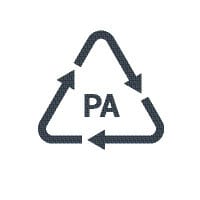
The final group, and second additional category is PA, or Polyamide plastic. It’s a very specific plastic with a relatively narrow range of uses, that can be thought of as ‘stringy’.
They can therefore be woven into clothing like a synthetic (and cheaper) version of cotton.
Again, these are considered a subset of OTHER waste and cannot be recycled (although some products may well be suitable for donation and re-use).
Examples Of PA Plastics
- Socks
- Women’s tights
- Toothbrush bristles (electric and manual)
Additional Markings Products Relating To Recycling
While this last section applies to all groups of plastics, it’s not limited to plastics, so is universal in relation to waste.
We know that you’re about to wonder why we haven’t provided a copy of the logos below – the reasoning is that our website isn’t recyclable (according to the definition) and you’re only allowed to put the logo on a product that is in the category! We’re probably being ultra cautious, but don’t want to get into trouble!
Widely Recycled Logo Or Markings
The first is a green square with a circular white arrow inside. It is usually accompanied by the wording Widely Recycled underneath.
The meaning is that over three quarters of areas offer council run collections for that item to be disposed of. In other words, you can place it in the most appropriate bin if you have one.
Check Locally Logo Or Markings
This logo is a black square with a circular arrow inside – to put it another way, a black and white version of the widely recycled logo. Underneath it reads Check Locally.
This means that there is a reasonable chance that local recycling is available, but doesn’t meet the 75% threshold for the green logo. It may also require the item to be recycled at your nearest HWRC or recycling site.
Not Yet Recycled
This logo looks like the Check Locally logo, but with a white diagonal line running through it from the top right to bottom left, with the wording Not Yet Recycled beneath.
The odds are against you having a waste collection service that will result in the item being recycled, so you’ll either need to find out if the nearest tip to you has a recycling option, or alternatively put it into your general waste bin.
How To Better Understand Plastic And Recycling
Knowing the 7 main symbols to identify plastic types will give you a huge advantage in dealing with plastic waste. While knowledge is power, you don’t really even need to know what the symbols relate to, beyond that groups 1 and 2 can go into a plastics wheelie bin for collection, and the rest either get recycled elsewhere or go into the general waste.
Fortunately, knowing what group a product falls into is much easier than many people realise. All plastic products should have one of the above group logos marked on them somewhere, it can just be quite hard to spot them.
The majority of people know that recycling is better than landfill, and they also want to do the right thing. However, recycling services still aren’t as good as they could be across Britain, and to really get people to buy into recycling in huge numbers it needs to be much easier.
